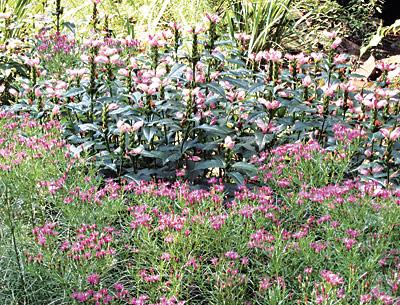Hunting for Plants at Home

To discover new garden-worthy plants you don’t have to slip and slide through snowmelt or scramble across unstable screes on remote mountaintops in Turkey as I did with great glee last month. All that is needed are visits to fine public and private gardens.
That is how three of the new plants I’m most excited about made it to the Garden Club of East Hampton’s plant sale at the Mulford Farm tomorrow evening and Saturday morning.
After checking to see how the new, long-flowering and disease-resistant roses at the New York Botanical Garden had withstood the ferocious weather of last August, I strolled through the new Azalea Garden. There, in a hillside clearing in filtered sun, was a mass of color, bright pink and purple. It was just after Labor Day, when you don’t expect to see such exuberance in the garden.
The perennial to the rear was easy to identify: Chelone lyonii Hot Lips, an East Coast native called the turtlehead. The purplish flowers in the front, though, were completely new to me, and the gardeners working in the area couldn’t help. A few weeks later I met the garden’s designer, Sheila Brady, a partner at Oehme, van Sweden who also is working on the new native plant garden at the botanical garden, and she identified the mystery plant as Vernonia lettermanii, the narrowleaf ironweed that is native to Arkansas. The turtlehead and the ironweed flower in August and September, and both are now growing in combination at Mimi Meehan’s Native Plant Garden behind Clinton Academy.
The other two new perennials, also native plants, had been incorporated in the Battery Conservancy gardens in Lower Manhattan by the Dutch designer and plantsman Piet Oudolf. When encountered for the first time in mid-July a couple of years ago, they left me gasping and lusting. Scutellaria incana was covered with long-flowering blue spikes, and from the distance Phlox paniculata Blue Paradise appeared deep purple. Neither has been easy to obtain. Phlox Blue Paradise, introduced by the Dutch designer, is deservedly so popular it has been selling out long before the season begins. Last week, I visited the plants for the Garden Club sale, and two dozen have our name on them. Come early.
The scutellaria didn’t seem to be commercially available although it is native to nearly the entire country east of the Mississippi, except New England. One Midwest nursery grew it, but doesn’t have mail-order. Thanks to persistent requests, Glover Perennials has begun growing it, and we may have a dozen and a half plants at the sale. Don’t expect flowers yet, but the very narrow foliage is good looking and they will provide a treat in August.
The Mimi Meehan Native Plant Garden, thanks to the generosity of her family, has become my test garden, or playpen, to study plant performance in our area. Two plants that were new last season have been very successful: the tickseed Coreopsis Full Moon is clear canary yellow. If you have ever had to dead-head coreopsis, you’ll appreciate that Full Moon is self-cleaning and flowers nonstop until Thanksgiving. It may be a little taller than expected so I’ve been instructed to cut it back (about one-third) to keep it low and bushy. We did that with a hedge clipper last week.
A verbena that is really hardy and long-flowering is worth its weight in gold. V. canadensis Pink Pepper has proved itself. It’s a terrific bright pink, front-of-the border plant, and we’ve expanded the native plant garden with it.
Maybe you can do your plant hunting at the Mulford Farm this weekend. Leave the scouting to us, and you get to mix and match. This is only the tip of the iceberg, as it were.
